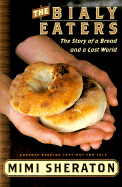|
The Bialy Eaters: The Story of a Bread and a Lost
World
By Sheraton,
Mimi
How important is an onion-topped roll
that is usually served with a schemer of cream cheese? Well, Mimi
Sheraton would tell you that it is important enough to travel around
the world for seven years.
She started out her journey, with a
dozen carefully wrapped American Bialys to ward off the potential
translation problems and headed to Bialystok a small Polish town.
She was in search of the people who had invented this marvelous
bread. Instead of finding these people, she found a city in utter
desolation, where massacres, followed by the Holocaust had reduced
the number of survivor's form 5,000 to 5.
She traveled to Israel, Paris, Austin,
Chicago, Buenos Aires, Miami Beach, Chicago, Scottsdale, Beverly
Hills, and New York. Through her investigation she found Pesach
Szsemunz, and ex-Bialystoker and bialy baker who some how survived
Auschwitz and now lives in Australia. The overriding discovers is
that modern day bialys are flaccid as compared to those of the past.
They are under cooked and not salty enough. The depression in the
center should be dark and crisp while the outer crust should be
dark and chewy.
A bialy is the bagel's much overlooked
and forgotten cousin. Tender, chewy, and when cooked properly, crispy
and brown, topped with onions and poppy seeds with a tucked in depression
(not a hole) in the center of each roll.
The books final chapter adapts a recipe
for the home cook. The recipe takes five and a half pages. Not that
it is that complicated, but Sheraton gives you complete explanation
for each step. Now one warning, if you want to make them for breakfast
you would have to get up at oh around 3:30.
The people from Bialystok may not have
survived, but the bialys do live on, delighting all those who eat
them. They are a tribute to endurance of tradition and the power
of ones everyday life.
|


